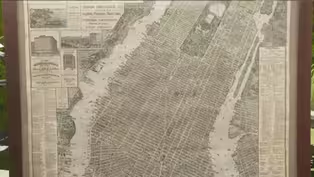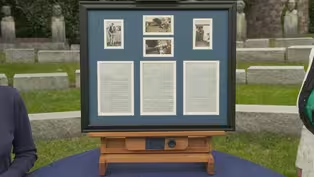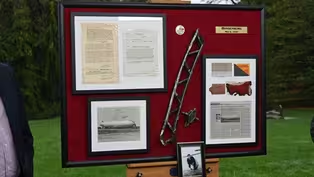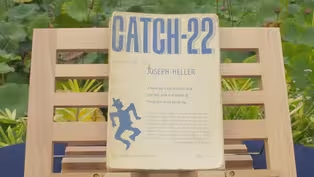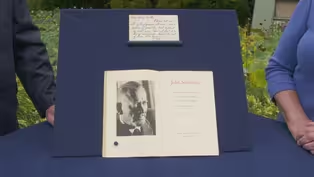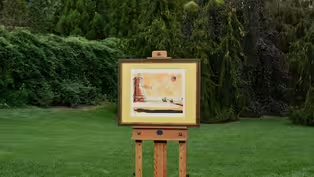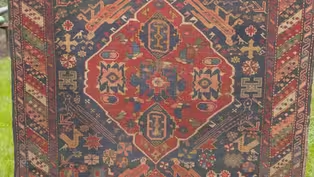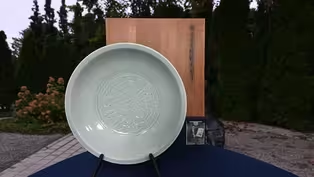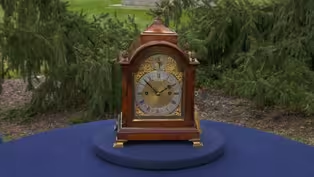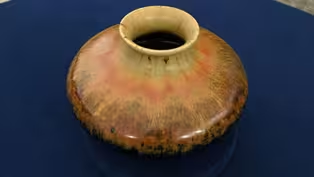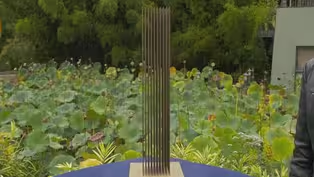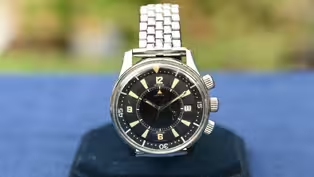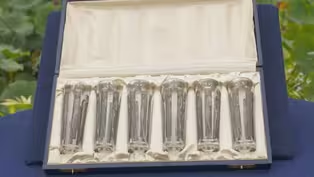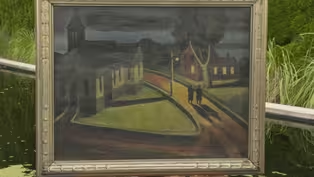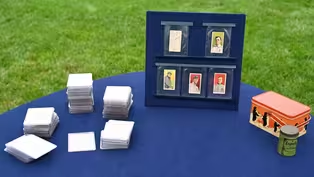
Grounds For Sculpture, Hour 1
Season 26 Episode 10 | 52m 24sVideo has Closed Captions
ROADSHOW reveals remarkable appraisals at Grounds for Sculpture, like an $80K-$120K find!
ROADSHOW reveals remarkable appraisals at Grounds for Sculpture, including a Chinese imperial celadon charger, a 1968 “Yellow Submarine” animation cel and a Harry Bertoia sonambient sculpture. Which appraisal is a shocking $80,000-$120,000?
Problems playing video? | Closed Captioning Feedback
Problems playing video? | Closed Captioning Feedback
Funding for ANTIQUES ROADSHOW is provided by Ancestry and American Cruise Lines. Additional funding is provided by public television viewers.

Grounds For Sculpture, Hour 1
Season 26 Episode 10 | 52m 24sVideo has Closed Captions
ROADSHOW reveals remarkable appraisals at Grounds for Sculpture, including a Chinese imperial celadon charger, a 1968 “Yellow Submarine” animation cel and a Harry Bertoia sonambient sculpture. Which appraisal is a shocking $80,000-$120,000?
Problems playing video? | Closed Captioning Feedback
How to Watch Antiques Roadshow
Antiques Roadshow is available to stream on pbs.org and the free PBS App, available on iPhone, Apple TV, Android TV, Android smartphones, Amazon Fire TV, Amazon Fire Tablet, Roku, Samsung Smart TV, and Vizio.
Buy Now
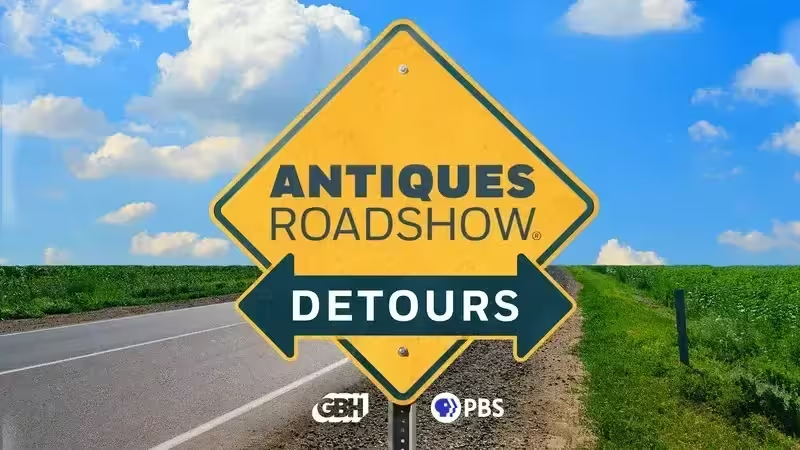
ANTIQUES ROADSHOW DETOURS
Ever wondered what happens to the treasures featured on America’s beloved ANTIQUES ROADSHOW after the cameras leave town? Host Adam Monahan tracks down the juicy afterlives of your favorite finds from PBS’s hit series.Providing Support for PBS.org
Learn Moreabout PBS online sponsorship♪ ♪ CORAL PEÑA: The sky's the limit when it comes to "Antiques Roadshow" finding treasures at the Grounds For Sculpture in Hamilton, New Jersey.
My favorite thing to do is just take one of these... (rods clanging) Really?
(laughs) ♪ ♪ PEÑA: Grounds For Sculpture is a New Jersey gem.
The former home of the New Jersey State Fairgrounds, Grounds For Sculpture was created to promote the understanding of and appreciation for contemporary sculpture in a beautiful natural setting.
Since the park opened in 1992, more than 700 artists have had their work displayed here.
Today, there are more than 300 pieces in the collection.
It's a beautiful day to look at the art and antiques that our guests have brought to this lovely place.
Check it out.
Well, this screen has spent the last 40-odd years sitting in a dining room in a small town in Central Pennsylvania.
It came out of a showroom in New York City on Madison Avenue.
My father manufactured ladies' lingerie, and this screen was in the showroom, and it was used to hide the models before they would come out and show the buyers the garments.
Wow!
(laughs): Yes.
If this thing could only talk.
(laughs): Yes, well, it saw a lot of naked butt.
Okay, so... What year was that?
The showroom was decorated in the 19, mid-1950s.
Okay.
When they morphed from being a manufacturer into being a contractor, all the antiques in the showroom were dispersed.
My mother chose this screen to grace her dining room, and it's been in that dining room ever since.
Piero Fornasetti was an industrial designer who designed thousands of things, and one of his iconic things is these room screens.
He put these images on lacquered wooden panels.
And he did lots of different subject matter: classical subjects, libraries, uh, musical instruments-- you name it.
And people today love these.
If I had to put a date on this, I would say circa 1960.
It looks like you have replaced the hinges and the casters.
Yes.
Well, I love looking at this.
This is like an English gentleman's closet.
On the other side, it looks like a library.
I was under the impression that they never repeated the same front with the same back, that they were all different.
Sometimes they would have a less busy design on one side.
And the distinctive thing about this is, both sides are very graphic.
I did a lot of checking and talking with colleagues, and, uh, an insurance value in today's world would be $15,000 for this.
Uh, if it had more of the original hardware, maybe, and a little less wear, you might take it as high as $20,000.
Fornasetti's son runs the company now, and they reproduced these in the '80s.
So some... That I didn't know.
Yeah, sometimes you'll run into the reproductions, but this is definitely one from the period.
(laughs) WOMAN: Well, my husband bought it in 2009 online, and, uh, we bought it for the, uh, glaze.
We love the glaze on it.
On the bottom, it says that it's Grand Feu.
Mm-hmm.
And it has a number.
And what did you pay for this?
Uh, $1,500.
$1,500.
Okay, well, you bought it for the glaze, and that's a really good reason, because this is extraordinary.
Uh, it's a piece of Grand Feu pottery from Redlands, California.
And what happened is, the potters discovered around the turn of the century that the clay deposits in California in general were among the best in America.
So it inspired a whole generation of art potters from around 1900 to about 1920.
This is a high-fired piece, "grand feu" means high fire.
It's called gres ceramics, G-R-E-S, is gres ceramics, and it means you can fire it at a very high temperature, and consequently, the glaze and the body mature at the same time in the kiln.
It's one of the reasons you get these dazzling glaze effects on this.
You've got a flambé of four or five colors ending over this beautiful cobalt blue.
It's called the sunray glaze.
It's one of the glazes they're famous for, and you don't really see it very often.
And normally what happens when you see the sunray glaze, the browns flow down so much, the cobalt's almost entirely hidden, and this is one of those rare examples... Mm-hmm.
...where you have this feathering of color throughout, and then this uneven drip over the cobalt.
It's just a, a really perfect example of one of the rarest of American potteries.
They're in business for less than four years.
So little information is known that they're not sure if they started in 1912 or 1913.
And by 1916, they were pretty much done.
Mm-hmm.
And they mark in some ways the high point of the American art pottery movement, to reach this level of quality, uh, in, in a pot at that time in America.
This is very well marked, Grand Feu Pottery, and L.A., California.
It's actually just outside of L.A. this was made.
And the company was, uh, run by Brauckman, also a mystery.
I'm not really sure where he came from or where he went after he was done.
He had this brief moment, made some beautiful pots, and then disappeared.
In terms of value, you said you paid $1,500 for it.
Mm-hmm.
At auction, I would estimate this for $10,000 to $15,000 now, on today's market.
Wow.
Yeah, and, and it could well bring more, because it's really that good.
The only better example I know of is in the L.A. County Museum with this particular glaze combination.
Well, this is a beautiful piece to look at.
Whenever you're feeling a little bit down or blue... (chuckles) ...you look at this, and it changes everything.
And then you feel cobalt blue.
Yes, yes.
♪ ♪ PEÑA: The Sculpture Court was once the site of horse and car racing in the 20th century.
Now it makes many art lovers' hearts race as they take in the artwork, such as "The Nine Muses," by the accomplished stone sculptor Carlos Dorrien.
I happen to love estate sales, and I love seeing beautiful works of art.
I came across this one a few months ago.
Ah, uh, how much did you pay for it?
Oh, I paid $22.
And I love it, I love the colors, I love everything about it.
And it's hanging in my office.
Oh, excellent.
And so, were you able to find out anything about it that you can share with us?
I just found out a little bit about the artist, that he was one of the first African American comic book illustrators, is what I read.
Mm-hmm.
And that he was from Harlem.
I know he's deceased.
Okay.
And that's it.
The artist, that's Alvin Hollingsworth.
As you say, he's from Harlem, but his parents were from Barbados.
Okay.
And he was born in Harlem in 1928, which is only nine years into the Harlem Renaissance, a very significant period in the development of African American art across the board.
In other words, not just visual art, but literature, et cetera.
And this piece is a color lithograph.
It is numbered at the bottom left corner in pencil, 99 over 250.
In the middle is the title, "Attack at Dawn," and to the right, it's signed A.C. Hollingsworth.
It's not dated.
So, I would actually say this piece was probably done in the late 1970s.
And this is from his "Don Quixote" series.
So that's actually Don Quixote and his partner attacking these windmills that they think, or at least he thinks, is a ferocious giant.
Lithographs are done either traditionally on stone, or now, more modern times, they use either metal or, uh, plastic.
So there's one plate for each one of the colors that you see in this image.
I noticed it's not sealed in the back.
And the problem with that is, insects can get in there.
Oh...
So sealing the back prevents that from happening.
In terms of the value, do you have any sense of how much you think this might be worth?
No, I don't-- it was kind of all over, and, um, to me, I like it, so...
It doesn't matter, right?
And that's beautiful.
But you, you paid $22 for it.
I did, I did.
And I would place it at around $950.
Wow, wow.
Which is not too bad a return on your investment.
Right.
(both laugh) Right?
Oh, my gosh, and I like it, that's the thing.
And that's the best part.
Oh, thank you so much, I really appreciate this.
Thank you.
Excellent-- my pleasure.
Thank you again for bringing it in.
Oh, most definitely.
WOMAN: It was a gift for my husband.
We happened to wander into a gallery.
It was $750.
So this was the early '70s.
Mm-hmm.
That was two months of take-home pay for me.
Although my husband and I both loved it, we had to pass on it.
Yeah.
However, driving home that day, I kept thinking, "This would be a wonderful surprise, because I, I just know he would love it as a birthday surprise."
So I called the owner of the gallery, and I proposed to him that I would pay it out on a monthly basis if he would allow me to buy it, and it would take me six months.
He agreed.
Mm-hmm.
And at the end of the six months, I drove back to the gallery, handed him the check, when he turned to me and gave me a surprise, and said, "I'd like to buy this back from you for $1,100."
Well, I was stunned.
Did a quick debate in my mind.
I decided I would keep it and surprise my husband on his birthday with a good story to go along with it.
Did you know who the artist was?
Or he told you...
He told us who the artist was.
Mm-hmm.
But I never had heard of him before.
Uh-huh, so, Harry Bertoia was born in Italy.
He came here as a young man, and he wound up studying at the Cranbrook Academy.
He eventually became the head of the metalworking department.
He was invited to California to work for Charles and Ray Eames manufacturing furniture, and then he worked for Florence and Hans Knoll in Pennsylvania, designing furniture for them.
The Knolls were the premier makers of furniture in the 1950s and onward.
And he designed a wire mesh chair, which is still in production.
Mm-hmm.
And is one of the iconic examples of mid, what we call mid-century modern furniture.
He made these starting in the 1960s.
It's made out of beryllium copper.
These are called sonambient sculptures, and they were made to produce sounds.
And he made them in hundreds of different variations.
So this is sort of the simplest, with just plain rods, beautifully constructed.
I've seen them ten feet high.
Many of them have cattails, they have cylinders at the top, different lengths, they can be narrow, they can be wide.
He set them up in a barn and he used to hold concerts, and he made recordings, and you can go online.
Mm-hmm.
And you can hear some of these pieces as he sort of performed.
It moves, so it's sort of a kinetic sculpture, which was popular at the time.
My favorite thing to do is just take one of these... (rods clanging) And it just reverberates.
And I love to hear it.
It takes a while to stop.
I never would have done one.
(both laugh) I'm, I'm simple, I'm just a simple person.
I'm sorry, I would have, I would do this.
(laughing) (rods clanging) It has a great sound.
It does, I agree.
And it's beautifully made, it's just so simple, and you can see how, how it's joined at the base, very, very simply done.
His son Val Bertoia also made these later on, and they're very, very similar.
So sometimes his works get mixed in with Harry's work.
And you bought it a long time ago, enough that it would not have been made by the son.
His work is very, very desirable now.
And of course it all depends on the size and the...
Okay.
And, and all of that.
But this work in, in a gallery would be between $20,000 and $30,000.
(exhales) Mr. Langman, $1,100.
Ah.
It was a, it was a profit at the time.
Yeah, yeah.
But I'm glad I kept it.
I also feel lucky.
And thank you, thank you, thank you.
This is one of the most exciting things I've had come in to "Antiques Roadshow."
What can you tell us about it?
Um, it's six foot tall, I'm six-three.
It's only about 40 pounds.
I acquired it in 2007 in Montreal.
Mm-hmm, mm-hmm.
The, uh, border crossing was not easy.
(chuckles) They did, uh, X-ray the lion to make sure it's not full of, uh, contraband.
(laughs) I was told that it was brought to Montreal for the 1976 Olympics.
Mm-hmm.
I've been trying to find any pictures of this on the German Olympic Village site, but I can't.
But that squares with the style of construction and the likely date of it.
It's in spectacular condition.
It has a few little bits of wear, but there's no real damage to it.
And I'd have no problem putting insurance estimate of $3,000 to $5,000 on it.
Great, thank you.
♪ ♪ WOMAN: These are pictures of, uh, Amelia Earhart, who-- the original pictures taken in 1932 in Derry.
I was there in 1965 and got to know my aunt.
And so I wrote to my aunt and I said, "Do you know anything about this 1932 trip?"
I knew she was a photography buff.
And I got a letter saying, "I was there, I took pictures, and here they are."
And this is the family that she went to, and she went to them and said, "Where am I?"
And so my aunt told me a great deal about this 1932 trip, and my husband took them out and had them framed for me and gave them to me for Christmas.
This is, um, a very well documented trip.
And you mentioned Derry.
We're talking about Derry, Northern Ireland.
This was May 21, 1932.
And she'd, had actually taken off from Newfoundland.
Right.
The Harbour Grace Airport in Newfoundland on May 20.
Shortly after takeoff, she not only apparently had a broken altimeter, but she noticed a, a weld had popped in her fuselage and it was allowing fuel to leak into the cabin.
She did tell her husband, when she phoned to let him know that she was okay, that she chose to fly very low over the ocean because she said that if she were going to crash, she would rather have done it in the water, and she was afraid of flames inside the fuselage, and with the fuel leak, she was worried that that could happen.
Five years to the day, she was planning to land in Paris.
She was trying to, to do a, kind of a five-year anniversary of Lindbergh's flight, but to do it as a woman.
And she unfortunately did have to land early, and she said she knew that the minute she saw land, which was Ireland, she was going to find the first field that looked like she could land.
She was known as Lady Lindy back then.
She was already quite famous.
You mentioned this family, this is actually the McLaughlin family.
Okay.
Um, we have some other newspaper shots from the people that she met when she landed, and the farmhands all came out and greeted her at the plane, and she asked them to extinguish their cigarettes because of her fuel leak, and of course the famous line, "Have you come far?"
Yes.
(laughs) And she said, "Well, just from America."
So this flight is such a historic moment, obviously, for aviation but more so for, of the first woman to transatlantic solo.
Right.
In addition to that, which is her most famous achievement that day, it was actually the longest nonstop flight a woman had ever made, which was 2,026 miles.
And it was actually the fastest transatlantic solo trip.
So she actually beat Lindbergh, because he all, went all the way to Paris, but she did it in about 14 hours and 56 minutes.
So she achieved a great number of things that day.
Yes, she did.
She also, after this trip, became the first woman to win the Distinguished Flying Cross, which was awarded to her by the vice president.
So it was a, quite a big deal.
It's a really important moment, and you have wonderful original photos.
I think for everything you have here, with the four photos and the letter, is in the $4,000 to $6,000 range.
Oh, I'm surprised with that.
That's very nice, thank you.
MAN: Well, this was, uh, my brother's guitar.
My brother took part in local community theater, and he would also perform in a band sometimes.
Ah.
And he's also a guitar collector.
So he passed away about ten years ago.
Ah, I'm sorry.
And I was, uh, lucky enough to, to get this one.
Well, do you, uh, know what this model is?
Yeah, a Gibson Explorer limited edition.
And, um... And this is the 1976, '76... Is when this was made.
Oh, '76, oh, okay.
He must have bought it fairly quickly... You think he bought it new?
I thought he... Yeah, I think he bought it, must have bought it new.
The original Explorers were made in 1958 and '59, and they were kind of a, a dud.
They were made out of Korina wood.
This is mahogany, made basically as a reproduction of the original Explorer.
Now, Gibson has just done this again, and made a, a reissue of the original Explorer in Korina wood.
Wow.
Made like the old ones.
Mm-hmm.
I think a lot of people were turned off by the shape in the '50s, but then, since then, have be, become a very collectible guitar.
The original ones are well over half-million, up to a million.
Wow.
Um... Yeah, I do like the tone on that.
Yeah, these sound great.
This is in pretty good shape overall.
It has some normal gold wear, which is not unusual, and it's got some pitting, but... And you can't clean this with any solvents.
The best way to clean these is saliva.
Oh, okay.
(chuckles) Just enough acid to break down the oxidation without damaging the plating.
Oh, that's good to know.
It's a sought-after year for the Explorer, because of '76, when they came back, was kind of the first time.
So retail is probably in the $3,000 to $4,000-ish range.
Okay, that sounds good.
So... Yeah, it's, I mean, it's pretty cool, and I suspect it will go up from there.
Well, that's good to know.
(chuckles) MAN: My whole life, it was hanging up in my grandmother's house.
Um, I didn't think much of it, I always sort of noticed it, um, and as I got older and started getting into the Beatles, and, um, finally, I watched the "Yellow Submarine" movie, and I realized, "Hey, I think that's what's at my grandma's house."
And so I went over there and I took it home with me to sort of examine it a little bit closer, and it's been with me ever since.
(laughs) That's cool.
It definitely is an animation cel from "Yellow Submarine," which was done in 1968.
And the whole premise of the movie was that the inhabitants of people who lived in Pepperland, uh, were being besieged by the Blue Meanies.
These are the villains who hated music.
But the key to the value in these is who's in that.
So if you have a Beatle in it, or you have a Blue Meanie in it, that's the best you can get.
Great.
Uh, Yellow Submarine added in would be good, too, because that's another key feature of the movie.
Historically, at auction, a piece like this, I would expect it to sell somewhere between $900 and $1,200.
Oh, okay.
Uh, John Lennon always commands more money.
Yeah.
If you had John Lennon, could be anywhere from 25% to 50% more in value.
Okay, wow.
Sorry, Paul.
(laughs) PEÑA: The Museum Building was originally the 1940s Rabbit Building from the New Jersey State Fairgrounds, which had once been used to house animals like rabbits and goats.
The two buildings behind it were built in the 1920s for the fair: the Domestic Arts Building, once used to display new household gadgets, and the Motor Exhibit Building, a space that exhibited farm equipment.
WOMAN: I brought a pre-publication copy of "Catch-22" that belonged to my in-laws.
They had it for, since 1961.
It's a pre-publication copy-- in other words, it came out before the first edition.
And the point of this book was to put out some copies so that bookstore owners and buyers for chains could read it, reviewers could read it, so they could give it publicity.
How did the in-laws get that?
In September of 1961, they took a weekend trip to New Hope, Pennsylvania.
When they were there, they befriended another couple who happened to be staying at the same place where they were staying, and at the end of the weekend, the man of the other couple told my in-laws that he had written a book that was about to be published and he wanted to give them a copy of it.
And it turns out that the man was Joseph Heller, and my in-laws had spent the weekend with Joseph Heller and his wife about a month before the book came out.
What adds to this one, if you open it up, tell me what it says.
"To Stella and Rube with the futile hope "that you will enjoy this book as much as we have "enjoyed your company, Joe Heller.
New Hope, Pennsylvania, September 1, 1961."
First of all, pre-publication copies, they don't send them out very much anymore, because they email the books.
You're not going to get this going into the future.
Condition-wise, it's actually in good condition... Oh.
...for a book like this because the paper, they weren't made to last.
Yeah.
They weren't made to be as graphically beautiful as the, the book that went into the store.
"Catch-22" is probably one of the classics of the 1960s.
There are very, very few books in the English language... Mm-hmm.
...where the title of the book has become part of the language.
It's a satire.
The main character is Yossarian, he's a bombardier.
He wants to get out of the war, he's afraid, he's, thinks he's going to be killed.
They keep saying, "Well, at this many missions, you're out," and then they keep raising it and raising it.
Right.
And he complains to the doctor, and the psychiatrist says, "Well, all these people who don't complain, "they're crazy.
You, you'd have to be crazy to keep doing this."
And Yossarian says, "Yes!
I, I'm doing, I want to get out."
He says, "Well..." You can't.
"But if you say "that you know that this is crazy, proves you're not crazy."
Right.
Catch-22.
Some people very much want these pre-publications.
Some people want the book as it came out, because it's prettier, the dust jacket.
It's what, the way they remember it when they read it.
Some people want both.
Yeah.
So, in this case, this pre-publication copy, signed, retail, is a $3,000 to $4,000 book.
Really?
Wow, that's amazing!
Getting it with a nice inscription in it, it was obviously personal, that he didn't just sign it for somebody.
Ah, yeah.
That add, all adds to the value.
It's an old map of New York, and, uh, my father had it in his, uh, basement for, uh, about 45 years.
He had it glued to a large piece of mat board.
Around 15 years ago, he came to me and he said, "I, I thought this, this map might have some value, and I want you to have it."
So I, uh, I took it and, and I had it restored.
He told me that he, he found it in the 1960s.
I don't know how much he paid for it, but knowing my father and giving the times, I'm guessing he probably paid very little for it.
But he told me he found this wrapped up in a small antiques store in, in Western New York, and it wasn't in very good shape.
But I don't think he knew what he really had until many years later.
I, I, he once showed me a reference book that identified this map, which indicated it had some value.
Mm-hmm.
This is the 1879 Galt and Hoy bird's eye view map of Manhattan and parts adjacent.
For my money, it's one of the most important pieces of American cartography from the 19th century.
It's absolutely fantastic, well over six feet tall, and it shows, unlike any other mapping of New York from this period, every single building in the city in great detail.
The producers, Galt and Hoy, came together as a partnership in 1878, and Henry Hoy was the one who was providing money for the partnership.
Producing a view like this, getting an artist like Will Taylor to go around the city and make all of the surveys and notes that he would make and all the drawings, and then eventually give it to a printer, that was considerably expensive work.
And it drained the firm of money to the point where Henry Hoy was bankrupted.
And so, in 1878, he actually committed suicide, because he was in such a desperate position.
The firm continued on for about a year, probably using the money that he had left it to continue the production of this view.
So this was finally published in 1879.
And it's those sort of tragic circumstances that we think probably contributed to the map's rarity today.
In the 1990s, when this first started to get some recognition, there were two known copies in institutional collections, at the New York Public Library and the Library of Congress.
Down here is one of the things that I find most fascinating about the map.
You can actually see, named on a building here, Galt and Hoy.
(gasps) It's difficult to read here, but that was their office in 1878.
And that, you may recognize, is in the footprint of the World Trade Center.
Oh, my goodness.
So that building right there would have been 4 World Trade Center.
Now, I told you that in the 1990s, there were two known copies of this.
Another copy came up that was held privately, and I was told by a friend of mine who handled this sale that he had framed up that privately held copy and held it for the buyer for about a year.
And then finally, they decided to put it in an office.
And that office they put it in was at the World Trade Center, and they put it there the week before the September 11 attacks.
Oh, my goodness.
So unfortunately, that example was destroyed in the attacks.
Oh, my goodness.
And it's one of those in, very tragic circumstances that ties this piece so closely to the history of New York.
It's actually in quite a bit better shape than the institutional copies that I've seen.
Really?
The census we've updated a little bit.
It's probably one of five or six known examples now.
Still not very many.
I think if I were to put an auction estimate on this today, in its current condition, I would estimate it at $40,000 to $60,000.
(inhales): Wow, I'm, I am, I'm shocked.
(laughs): I think my father would, would be very, very pleased and asto...
He had a, a good eye, but that, that number is shocking to me.
Wow.
I had the, the slip to have it restored.
It might have been $2,500 or certainly less than $5,000.
Mm-hmm.
Which I thought at that time, I'm, like, "Oh, my God, what a colossal waste of money."
(both laughing) WOMAN: This is John Steinbeck's Nobel Prize speech that he gave when he accepted in 1962.
And the postcard was to me.
I worked as publicity director at Viking.
I had asked Mr. Steinbeck if he would have an interview with a Japanese press person.
Mm-hmm.
And he wrote back, "Please get me out of the Japanese interview..." Uh-huh.
"...with honor if possible..." Uh-huh.
"...but without if necessary."
Right.
"I do not feel like being interviewed.
"Maybe I'm out of town.
Who knows?"
(chuckles) So it's a signed copy of his speech.
Correct.
But what makes this special is the postcard with the speech.
I would always keep those together...
Okay.
...to have that personal connection.
Right.
Only, like, that many steps... Mm-hmm.
...removed from the author.
As an auctioneer, I usually just look at auction values.
Mm-hmm.
And both of them together are probably worth about $2,000 to $3,000.
Really?
Yes.
(laughing): I'm so glad I carried them with me across the country.
(laughs): Uh-huh, right.
Thank you!
Oh, my pleasure.
Thank you.
PEÑA: Grounds For Sculpture's founder, Seward Johnson, was known for sculptures that celebrate the familiar.
Hyper-realistic bronzes like this one, titled "Viral Art," catch the eye because they register as being an everyday scene frozen in time.
It might even take you a moment to determine if the people you're looking at are real or works of art.
I brought a display of Hindenburg artifacts.
I inherited them from my father.
He was a career naval officer.
Just happened to be stationed in Lakehurst, New Jersey, on the infamous May 6, 1937, when the crash occurred.
He was on the ground landing crew that day running for his life trying to get away from the heat and the crash site.
He was, uh, very proud of the fact that he was there and able to help the survivors, and, uh, these are, uh, some of the artifacts that he had collected after the crash.
And it meant a lot to him in his life.
Right, like so many of the crew, he ended up, um, going from, uh, landing crew, helping with the mooring lines, to, uh, recovery and, and trying to clean up the, the disaster.
Exactly.
Exactly.
Yeah.
These are, uh, his personal commendations... Yeah.
...from the governor of New Jersey, um, the U.S. Department of Navy, and from, uh, the government of Germany, uh, in, in Berlin.
Right.
Personally directed to him, thanking him for his, uh, heroic duty.
Because he was instrumental in carrying off survivors that were still injured and...
Right.
And, and just below it is, um, a picture of the Hindenburg signed by all the surviving crew members of the Hindenburg as a memento of their appreciation.
The whole the body of the Hindenburg was covered in a special material.
Right, the skin, yeah.
Skin.
And that's the, um, surviving piece of skin.
This here, folded underneath, is a piece of the burnt flag off the Hindenburg.
And this was, uh, as you can see, fairly well scorched up.
So there were a lot of members of the crew there that day that grabbed artifacts.
And so we see on the market today bits of the superstructure, smaller pieces.
Um, there are sometimes spoons and forks melted together from the dining room.
But you've got a really great grouping here, um, one of the best I've ever seen of Hindenburg artifacts.
With this collection, there are, um, a lot of buyers out there.
Hm.
And it's very collectible.
So, at auction, I would put an estimate of $10,000 to $15,000 on it.
And I think it would do better than that.
Um, if you get a couple of the players out there, I think this would skyrocket.
A small piece of the, of the structure can bring a few hundred dollars.
So with this complete collection, I think that $10,000 to $15,000 as an auction estimate would be, would be a nice conservative one.
Great to start with.
Well... Yeah.
Great to start with, but I'm, I'm surprised, I, uh...
I really had no idea, but it's wonderful.
Yeah.
Yeah.
Now, if I was to put an insurance value on this, um, I would probably put a $20,000, $25,000... Mm-hmm.
... um, uh, value on it.
Wow.
Um...
I've never seen one this diverse.
All of these pieces together are, are fantastic.
Thanks for bringing it in today.
My pleasure.
WOMAN: My parents were given these for their wedding in 1954 from an old Army buddy of my dad's.
And do you know where the Army buddy purchased them or may have acquired them?
I... That I'm not sure of.
I know he was overseas, but I'm not sure where.
Mm-hmm.
What we have here is a set of six Lalique.
It's molded glass with gray patina.
And it's a set of goblets in the Six Figurines pattern.
It was designed in 1911, which is right when Lalique is doing a mass production of these items that they're selling in their shop out of Paris, and they're going all over the world and becoming very, very popular.
So this was kind of his Art Nouveau period.
So it's right before he, his Art Deco period, which he's most known for, in the 1920s and into the '30s.
Okay.
Each one will be signed on the bottom.
And we see here that it's engraved "R.
Lalique."
And that means René Lalique.
Mm-hmm.
So that's when René was still alive and still working with the company.
Um, after he passed away in 1945... Mm-hmm.
...they changed the signature, so it would just say "Lalique France."
So we know that we can date these to pre-war period because of how they're signed.
And then they continued producing these probably up until the '40s.
Because we don't see any that have occurred with the other kind of signature, so we don't think that they were produced past the 1940s.
So that's kind of interesting and cool.
Right.
That's cool.
A lot of old designs they continue and still produce them today.
Mm-hmm.
So these are more of a limited set.
There was also a decanter and there was also a vase in this pattern.
And so you could mix and match if you wanted to purchase them, if you wanted to purchase as a set, or if you wanted to purchase things individually.
Tell me about the box!
Uh, well, it's in the original box.
My parents kept it in a safe all these years.
So...
They didn't use them?
No, never.
(both laughing) No, I hardly ever even saw them, so.... (laughs) Oh, gosh, well, they're wonderful.
And they've got this great patina.
It's got the original box.
For Lalique collectors, this is something that would be very desirable.
At auction, these would likely bring between $3,000 and $5,000 today.
Oh, that's so cool!
(laughs) Yeah.
Awesome!
The box does add some value to it.
Um, and we always say, you'll probably get an extra bid or two just because it's in the original box.
WOMAN: About 30 years ago, there was a garage sale.
My brother saw this ship painting.
And he asked the guy how much he wanted for it, and the guy said $50, and he bought the painting.
(laughs) So it's been hanging over his bed for the last 30 years, and it hasn't moved.
This painting depicts a, uh, merchant vessel.
You could say it's, it's painted in the folk tradition.
It has this flat quality.
It's not nuanced.
It's really a very appealing picture visually.
So, I can say in the final analysis, it's definitely worth what was paid for it.
But is it worth considerably more?
I think as a decorative picture, somewhat more.
I mean, I might suggest perhaps $400 to $600.
Okay.
These are a collection of what I think are tobacco cards.
We found them in the home that we purchased in 1973.
We bought it at auction as a house and contents and we paid $16,000 for the house.
And in the process of renovating that place, we discovered these in a closet in this little tin, all secured inside of there with this little container of mothballs.
The gentleman that owned the house was a volunteer coach.
He founded a youth baseball league that still carries his name... Oh, that's... ...to this day.
And he was also inducted into the Eastern Shore of Maryland's Hall of Fame for Baseball.
Oh.
He was a bachelor and that was his passion.
He was born in 1895 and he died in 1983.
Okay.
1909 to 1911, the American Tobacco Company issued the T206 tobacco cards.
These came in cigarette packs as well as loose tobacco packages.
Oh.
And the American Tobacco Company advertised 16 different brands on the backs of these cards.
And here we have the Piedmont.
Most of yours are the Piedmont brand.
How many cards total are there?
153.
Yeah, I'm like a kid in a candy store.
When did you look at them again and say, "I might have something here"?
Off and on we would go back and revisit them.
And then my son got into baseball.
Mm-hmm.
So he actually was the one who said we should put these in sleeves and we should probably put them away in a safe deposit box.
And that's where they've been for about 20 years.
So they've rarely seen the light of day.
That is correct.
And that's what's amazing about this.
They, that is correct.
They don't all have perfect corners, but the color is phenomenal.
The quality of their printing process was far beyond the competitors of this era.
So the first Ty Cobb card is the Ty Cobb bat-on-shoulder variation.
Now, the Ty Cobb red portrait, which is the most valuable of the Ty Cobbs in this set-- you have two, that one and this one that we've turned around, also is a Ty Cobb red portrait.
And then what's interesting is, among this, you have the Ty Cobb card in the middle.
That's actually an E95 put out by Philadelphia Caramel.
So it's not done by the American Tobacco Company.
It's, uh, classified as a, at the same era, it's a 1909, uh, E95.
So the Ty Cobb bat-on-shoulder, on a scale of one to ten, it's probably a two or a three.
That one would sell at auction for $3,000 to $5,000.
The E95 Philadelphia Caramel, also $3,000 to $5,000 at auction.
Okay.
The red portrait, that's the most popular of his T206 cards, you have two of those.
Those would sell at auction between $5,000 to $7,000 each.
Wow.
The other thing about the T206 is, they have what's called the Big Four: the Honus Wagner, the Eddie Plank, the Sherry Magee, and the Slow Joe Doyle.
You have one of them.
Okay.
Okay, we don't have the Honus Wagner, unfortunately-- one recently sold for over $6 million.
I know... (laughs) The Sherry Magee and the Slow Joe Doyle are actual error cards.
Now, the T206 set is full of errors, but there's only those two that were corrected for some reason.
So, in your card here, we see Sherry Magee is spelled wrong.
His name was M-A-G-E-E, and they did correct that.
So the current population count for the Sherry Magee error card is that there's about somewhere between 112 to 115 that have ever been graded.
So it's easiest to attain of the Big Four, but it's still considered one of the Big Four because it was an error card that was corrected.
I would put an auction estimate of that one at $15,000 to $20,000.
Wow.
You have 153 total.
I would put a value on this at auction, for the entire group, of $45,000 to $65,000.
Very nice, thank you!
Not bad, since it came with the house.
I got it for $16,000 and a house included.
This is a watch I got from my father when he passed away.
That's 25 years ago, and it sat in my basement all this time.
It took me a long time to find out that it's a LeCoultre.
And I took it in to a dealer of the same brand of watch, LeCoultre, and they said it's authentic.
And they suggested they could get it repaired for me if it needed to be repaired.
I didn't know what to do at the time, and then, since then we moved, so it's been on hold.
Your watch is signed LeCoultre on the dial.
So we know that was made for the U.S. market.
The ones for the European market were made with a Jaeger-LeCoultre on the dial.
Okay.
This model is called the Polaris.
They started making them around 1965.
Yours has the broader, luminous markers on it.
So that would probably put it around 1967, 1968.
These were made for divers, and this is an alarm watch to tell a diver when they should come up.
I've never been underwater to hear what it sounds like, but they actually make noise and vibration underwater so that the diver would know.
They came with rubber straps because it was a diver's watch.
Oh.
So most people would look at that and say the bracelet's been added on.
That bracelet on this watch is the original bracelet.
Only for the U.S. market they put these bracelets on the watches.
So you have an original bracelet.
Hm.
And what's really nice about that bracelet is, it's, it's very desirable to collectors and very rare.
Now, the watch is a pretty rare watch.
There was less than 1,800 of them made.
Looking at the watch, you have some issues with the case.
It's, it's been worn.
The crystal, obviously, has got scratches.
That needs to be replaced.
That's not a big deal.
If you look at the hands of the watch, we see where the luminescent material is getting darker.
But still a nice watch.
Right now, the market, I would say, is a little bit on the softer side.
But in auction today, I would still put the estimate at $20,000 to $25,000.
(exhales) (laughing, voice breaking): Wow.
Wow!
Oh, that's great.
Oh.. What would your dad think today if he, if he knew that?
Well, I... (sighs) I don't know.
I mean, he got it from his neighbor, and, like, even if it was rare back then, it must have been a very nice gift for him to get.
And he must have thought a lot of my father, so I'm proud of him.
Had this been totally mint, maybe if you had the box and papers, things like that, I would put an auction estimate of closer to $35,000 on it.
PEÑA: This commanding figure, "General Bronze," was called an anti-monument by its creator, the Venezuelan American sculptor Marisol.
The military leader is based on General Juan Vicente Gómez, a Venezuelan dictator.
Looking through the rear of the horse, one can see a death mask of the general inside.
WOMAN: This is a painting by Max Arthur Cohn from the 1930s.
And I got it in the early '90s.
I was visiting my cousin.
This painting had been there forever, and she said, "Do you want it?
It belonged to your father."
And I said, "Well, yes."
Um, I never knew my father.
He died before I was two years old, and I had very little that belonged to him.
And my mother also died when I was quite young.
So we took it home, and the, um, signature is very clear.
And my husband thought, "Why don't we go to a gallery "that specializes in 20th-century art and see what they know about the artist?"
So we did.
The man in the gallery pulled out "Who's Who in American Art" and showed me Max Arthur Cohn, born 1903 and no date of death.
And I said, "Ah, I wonder if he's still alive.
"So maybe he lives in New York.
Do you have a phone book?"
(chuckles) Because of course, this was before the internet.
And he got out the Manhattan phone book and there was Max.
And I called him from the gallery, and I said who I was, and he recognized my name.
And it turns out he and my father were good friends, but Max lost touch with us when my father died and my mother and I moved in with her parents.
And he had always wondered what happened to me.
So he invited us over, and my husband and I went there the next day with the painting.
And we had a wonderful visit, and he told us all sorts of things about my father, about him.
And we saw them regularly for the rest of their lives.
He and his wife, Sarah, lived another several years.
They were in their 90s.
I...
I'm so happy, because it really gave me so much of my father that I never would have known if I hadn't gotten this painting.
Hmm, that's such a wonderful story.
Max Arthur Cohn was always considered really a New York artist, though he was of Russian descent and was born in London.
I think he came to New York at the age of two, and he really is best known for his WPA New York scenes.
So it's an oil on canvas painting.
Uh, we do have a signature in the lower right.
It's not dated, but I would venture that this is definitely a painting from the 1930s.
He, um, made a printed image, a serigraph, of this in 1938.
So probably the painting was done, I would guess, within a year or two of that, or maybe in 1938, also.
He's often called the pioneer of screen printing.
He created the National Serigraph Society.
He was one of the, the artists to start that.
And he really made it kind of his mission to make screen printing, or then he coined the term "serigraph," an appreciated fine art technique.
One of the things that people always note about him is that when he had his own graphic studio in the 1950s, Andy Warhol was one of his first clients.
Was the painting in this condition when it was given to you?
No, it was in fairly bad shape.
We had it cleaned and conserved.
It now presents very well, and I think with the conservation, you've really brought it back to kind of its best possible presentation.
I would estimate the insurance value to be $10,000.
Oh, great.
But, you know, the value is really secondary for me.
It's, you know, what I learned about my father and knowing Max that really matters.
WOMAN: So we inherited this from my husband's grandfather, and my husband's aunt said, "Your father loved this as a little boy.
Would you like it?"
So we said, "Sure, we'll take it."
So it came to live with us in our basement in a cardboard box.
And I just remember one Christmas, my son was about three, and he just loved Santa on the nodding donkey.
And that was the year that Santa went from the cardboard box to a Tupperware box.
Uh, it's really a neat little guy here from the 1940s.
Made in Germany.
This was probably made for F.A.O.
Schwarz.
Um, Schwarz was a big toy company and they wanted things made for them that you couldn't get anywhere else.
So, on today's market, at auction, I would put a conservative estimate of $800 to $1,200.
Uh, but like anything at auction, it could go for more.
We, we just love him.
And he, as you can see, it's very endearing, so... WOMAN: It is a celadon bowl that was a gift to me from my uncle who brought it from Japan.
He was a civilian director of the educational troops after the war.
So this was one of the things that he sent back.
Probably was made before the war.
So it's at least, uh, probably 80, maybe even 100 years old.
Okay.
It's very possible.
He obviously had planned to have a house, and put all these things in it, and then he went blind.
Oh.
As a result, this stuff sat in my grandmother's attic for a good many years.
And, uh, finally he rediscovered it and gave it to me as a Christmas gift to my husband.
I've actually got a picture of my cat sitting in that bowl at some point or another.
(chuckling) And it would hold a large cat, at that.
Yes.
This is a, a tremendous size.
Obviously, it's something we've just lived with.
But I've always felt it was special.
Celadon is a favorite of mine, as well, and it's a favorite of the Japanese, and has been for centuries.
There are a number of clues that I would look to to identify this, exactly what it is and where it came from.
The first is the label on this box.
Mm-hmm.
There's a label on the back of the charger, as well.
I wouldn't call this a bowl.
This is a charger.
Okay.
So an oversized dish that they would have maybe served oranges or just a large sort of dramatic display piece.
But there's a mark on the back.
Mm-hmm.
It's six characters in all.
And it indicates "Da Qing Yongzheng Nian Zhi."
Okay, Chinese.
And it's Chinese.
Now, how did a Chinese celadon charger of this type end up in Japan?
Well, it turns out that for centuries, the Japanese were the world's most ardent collectors of celadon wares.
There's a kind of a cliché.
Good things come in small packages.
Well, in the Asian art trade, good things come in Japanese boxes.
The Japanese were such fine, fine connoisseurs of the absolute most beautiful, the most sublime Chinese, Japanese, and other antiques, when we see a collector's box of this type, uh, it, it excites us tremendously.
Because the Japanese had such a long legacy of, of collecting, the knowledge was there, the connoisseurship was there, and this label, by the way, says exactly the contents of the package.
I've always wondered about this.
Yeah, essentially, it says "large celadon porcelain dish, Yongzheng period."
Okay.
So it's, it's good to see that the label matches the contents of the box.
Sometimes boxes and ceramics are kind of put together that didn't originally go together.
But this is a box clearly made to, to house this beautiful work of, of porcelain.
The dragon is sublime.
The glaze is impeccable.
And there's very few signs of age in this.
So I, I wouldn't blame you to look at it, or anyone for that matter, and, and not really see the history.
You can see the quality, you can see the beauty in it.
But the Yongzheng period is from 1722 to 1735.
Mm.
It's a very short period, but it's a period in Chinese history when some of the finest ceramics were made arguably of all time.
This is quite a discovery.
Have you ever thought about the value or do you have any idea what this would do at auction if it were sold today?
I, I have always felt that it was probably worth something.
I mean, maybe... $1,000?
And that's because I collect ceramics that are contemporary.
(chuckling): Sure.
And I know if I were buying something like this... Other than that, no idea.
The Chinese porcelain market is very strong right now.
And it's driven by Chinese tastes.
And, uh, this is something that I think would appeal to just a, a multitude of, of potential bidders and buyers.
Collectors who are looking for exactly this sort of ceramic.
At auction today, in 2021, I would put perhaps a conservative auction estimate of $80,000 to $120,000.
Oh, my... You... (laughing): Really?!
And it's under my bed all the time?
(laughs) I think under the bed is not such a bad place to keep this.
It's been kept beautifully and it's been kept safely.
That overwhelms me.
But you may wish to rethink under the bed.
(both laughing) I must say...
It's an absolute masterpiece.
I don't know what to say.
I think you've kept it very well for so long.
It's in very good hands.
Wow.
I'm so pleased you own this.
I feel like crying.
(laughs) PEÑA: You're watching "Antiques Roadshow" PEÑA: And now it's time for the Roadshow Feedback Booth.
And then I was very surprised at the appraisal and how much Laura knew about it.
It was a fun, fun day.
It really was.
We had a great time.
So I'm not selling it, I'm keeping it, but I'm, I'm still stunned.
And I'm a very happy person.
All the years that I was growing up, uh, my dad always said, uh, "Chrissy gets the goblets.
Chrissy gets the Lalique."
Um, my brothers were a little jealous of that, but I was the baby, so I got the goblets.
Because it was my father's, and it had a special meaning to my family, I'll take it back home and I'll have it as long as I live.
In 1973, we bought the house as a box and contents.
Even the gentleman's dentures were left behind.
We found 153 baseball cards.
And this is probably the fifth time they've seen daylight in 50 years.
This is... Well, anybody in the family that's watching this, would you, would our Uncle Ronald be absolutely overwhelmed by this right along with me?
(laughs) This is, this is one of the most astounding things that's ever happened.
I don't know what else to say.
(laughs) Plans right now are to take it home... Sale.
...and we'll figure out what we're gonna do.
Sale.
(laughing) Put in auction.
(laughing) Yeah.
That's my plan.
PEÑA: Thanks for watching.
See you next time on "Antiques Roadshow."
Appraisal: 1879 Galt & Hoy The City of New York Map
Video has Closed Captions
Clip: S26 Ep10 | 3m 58s | Appraisal: 1879 Galt & Hoy The City of New York Map (3m 58s)
Appraisal: 1932 Amelia Earhart Photos & Letter
Video has Closed Captions
Clip: S26 Ep10 | 2m 51s | Appraisal: 1932 Amelia Earhart Photos & Letter (2m 51s)
Appraisal: 1937 Hindenburg Archive
Video has Closed Captions
Clip: S26 Ep10 | 3m 11s | Appraisal: 1937 Hindenburg Archive (3m 11s)
Appraisal: 1961 Joseph Heller-inscribed Catch 22 Book
Video has Closed Captions
Clip: S26 Ep10 | 3m 1s | Appraisal: 1961 Joseph Heller inscribed Catch 22 Book (3m 1s)
Appraisal: 1962 Steinbeck-signed Nobel Prize Speech
Video has Closed Captions
Clip: S26 Ep10 | 1m 8s | Appraisal: 1962 Steinbeck-signed Nobel Prize Speech & Postcard (1m 8s)
Appraisal: 1976 Gibson Explorer Guitar
Video has Closed Captions
Clip: S26 Ep10 | 1m 58s | Appraisal: 1976 Gibson Explorer Guitar (1m 58s)
Appraisal: A.C. Hollingsworth Attack at Dawn Lithograph, ca.
Video has Closed Captions
Clip: S26 Ep10 | 2m 31s | Appraisal: A.C. Hollingsworth Attack at Dawn Lithograph, ca. 1979 (2m 31s)
Appraisal: Caucasian Kuba Rug, ca. 1900
Video has Closed Captions
Clip: S26 Ep10 | 34s | Appraisal: Caucasian Kuba Rug, ca. 1900 (34s)
Appraisal: Chinese Imperial Celadon Charger, ca. 1730
Video has Closed Captions
Clip: S26 Ep10 | 4m 35s | Appraisal: Chinese Imperial Celadon Charger, ca. 1730 (4m 35s)
Appraisal: Edward White Miniature Bracket Clock, ca. 1875
Video has Closed Captions
Clip: S26 Ep10 | 1m 3s | Appraisal: Edward White Miniature Bracket Clock, ca. 1875 (1m 3s)
Appraisal: Grand Feu Ceramic Vase, ca. 1914
Video has Closed Captions
Clip: S26 Ep10 | 2m 42s | Appraisal: Grand Feu Ceramic Vase, ca. 1914 (2m 42s)
Appraisal: Harry Bertoia Sonambient Sculpture
Video has Closed Captions
Clip: S26 Ep10 | 3m 44s | Appraisal: Harry Bertoia Sonambient Sculpture (3m 44s)
Appraisal: Jaeger LeCoultre Memovox Polaris Watch, ca. 1968
Video has Closed Captions
Clip: S26 Ep10 | 2m 48s | Appraisal: Jaeger LeCoultre Memovox Polaris Watch, ca. 1968 (2m 48s)
Appraisal: Lalique Six Figurines Glass Goblets with Box, ca.
Video has Closed Captions
Clip: S26 Ep10 | 2m 22s | Appraisal: Lalique Six Figurines Glass Goblets with Box, ca. 1930 (2m 22s)
Appraisal: Max Arthur Cohn Night Scene Oil, ca. 1935
Video has Closed Captions
Clip: S26 Ep10 | 3m 37s | Appraisal: Max Arthur Cohn Night Scene Oil, ca. 1935 (3m 37s)
Appraisal: Piero Fornasetti Folding Screen, ca. 1960
Video has Closed Captions
Clip: S26 Ep10 | 2m 43s | Appraisal: Piero Fornasetti Folding Screen, ca. 1960 (2m 43s)
Appraisal: T206 & E95 Baseball Cards, ca. 1910
Video has Closed Captions
Clip: S26 Ep10 | 3m 55s | Appraisal: T206 & E95 Baseball Cards, ca. 1910 (3m 55s)
Providing Support for PBS.org
Learn Moreabout PBS online sponsorship
- Home and How To

Hit the road in a classic car for a tour through Great Britain with two antiques experts.













Support for PBS provided by:
Funding for ANTIQUES ROADSHOW is provided by Ancestry and American Cruise Lines. Additional funding is provided by public television viewers.


